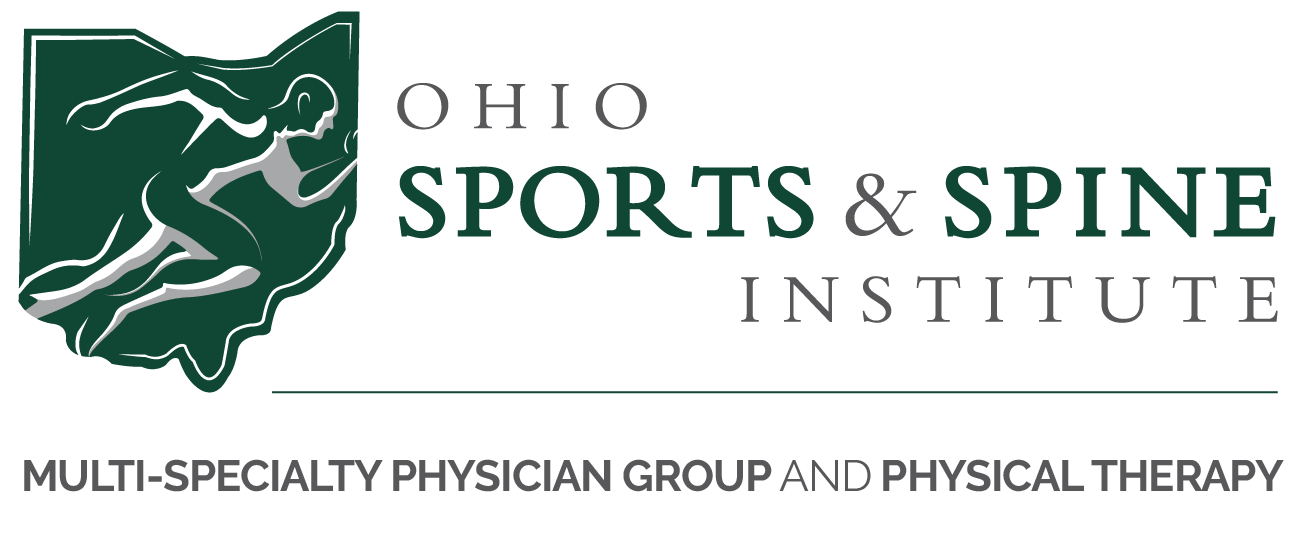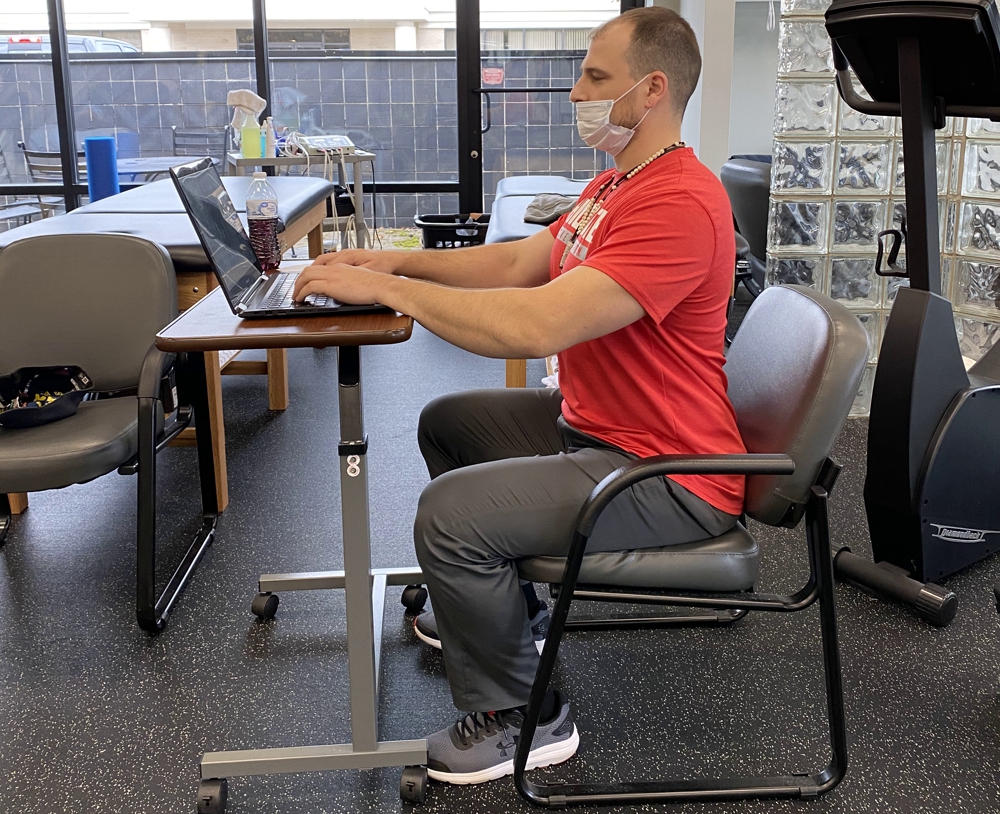By Edward Palestro, DPT
Since the start of the COVID-19 pandemic, many employers have implemented some form of a work-from-home model. Children participating in hybrid learning or online learning have also been spending much of their time at a home work station, sitting in front of a screen.
While every home office or work set-up looks different, each has one major thing in common – they require us to remain stationary for much of the day. Our home offices are typically within an arm’s reach of other areas in our house, and we don’t have the usual hustle and bustle we would have at an office, which results in us moving less.
The prolonged sitting posture and lack of movement can lead to kinks or even “breaks” in our body’s alignment. And just like a chain, when there is a change between one part of the chain and another, it results in less efficient function overall.
This can lead to the development of “tech neck” or “tech posture,” also commonly referred to as “text neck.”
Basic Anatomy of our Work-From-Home “Tech Posture”
If we start from the neck and work our way down, a classic sitting posture often results in a forward head and neck carriage and rounded upper back. This can lead to “upper cross syndrome.”
Anatomically speaking, upper cross syndrome results in tightness on the back side of the neck and upper back (upper trapezius and levator scapulae), which combines with muscle tightness along the anterior chest wall (pectoralis major and pectoralis minor). Over time, this results in weakness of the deep muscles of the front side of the neck (deep cervical flexors) that cross with weakness of the muscles in the middle and lower areas of the shoulder blades (middle and lower trapezius).
These imbalances can lead to underactive muscles with compensatory overactive muscles that are overworking to try to maintain proper joint integrity. The tightness and reciprocal weakness lead to joint dysfunction of the neck and upper back, as well as the shoulder joints.
Postural Tips/Movements
Our body needs to be exposed to gravitational forces to produce proper activation of muscles that are responsible for good postural stabilization. This happens while we’re standing or walking. When muscles are not stimulated by the force of gravity, their functions are ultimately disrupted. In “Tech Posture,” under-functioning muscle groups can cause an over functioning of compensatory muscle groups, and this results in decreased flexibility.
Here are some ways to combat this and encourage a healthy posture.
Work from a standing position
One simple thing we can do to prevent any imbalance is to work from a standing position for a prolonged period of time. Helpful methods might include setting your computer up at a counter, or raising it up on a crate at a table so it sits at eye level while you’re standing. Be sure to stand up right with good posture, focusing on not leaning into the counter or shifting your weight to one side.
Add a lumbar support cushion
When seated, be sure to observe proper posture with your feet flat on the floor, your arms bent at a 90-degree angle, your shoulders pulled back and your eyes level with the computer screen. To support your back positioning, add a pillow or a lumbar support cushion in between your lower back and office chair. There are also office chairs designed with built-in lumbar support cushions.
Utilize Brueggers Relief Position

Sit at the edge of a chair with your legs slightly apart and turned out slightly. Rest your weight on your legs and feet while relaxing your abdominal muscles. Tilt your pelvis forward and lift your chest to increase the curve in your lower back. Spread your fingertips widely and with your palms facing up, rotate your arms slightly outward and behind you, with your thumbs pointing behind you.
It’s recommended to perform this relief position for 10 seconds every 20 minutes. Remember to breathe while holding this position.
Perform chin retractions
In a seated position, look straight ahead and allow yourself to relax. Move your head slowly and steadily backwards until it is pulled back as far as you can manage. Keep your chin slightly tucked down so that you have a “double chin” and retract to the maximum degree possible. Maintain this position for a few seconds and then relax, allowing your head and neck to protrude again. Perform this exercise 10 times per session and repeat six to eight times throughout the day.
Upper Body Stretches/Exercises
Here are some stretches and movements that you can perform throughout the work day to help alleviate tension and tightness. These can help to strengthen the muscles that support good posture.
Wall angels

With your back flat against the wall, go into a half-squat position and bend your arms at a 90-degree angle in a “touchdown position.” Slowly raise your arms overhead while keeping your shoulders, elbows and wrists in contact with the wall. Once you reach the end range of motion at the top, begin to slide your arms back down. Pinch your shoulder blades together while maintaining all points of contact with the wall. Repeat this movement 15 times and complete one to two times per day.
You can also perform this movement while lying flat on your back on the ground, focusing on keeping contact with the floor instead of the wall.
Carpal tunnel thumb stretch
Bend your elbow and place your hand in front of you. Take your opposite thumb and interlock it with the thumb being stretched. Gently pull the thumb that is being stretched out and back. Repeat with your opposite thumb. Do this hourly for 20 second holds on each thumb.
This is particularly important if you type a lot. It helps to mobilize the tendons to prevent carpal tunnel syndrome.
Prayer stretch
Place the palms of your hands together in front of your chest as if in a prayer hand position with your fingers pointed upward. Then lower your hands in front of your chest toward your stomach to stretch your wrists. Do this stretch 20 times for five second-holds every hour.
Lower Body Stretches/Exercises
Prolonged sitting also presents problems for the lower half of our body. After an extended period of time of sitting, our neurological system reinforces sitting rather than weight-bearing positions. This compounds over days, work weeks, months and years, and results in the remodeling of our tissues, especially on the front side of the hip, leading to tightness and adhesions. This affects our ability to maintain good posture and regular biomechanics with our normal walking cycle.
Tightness in the anterior hip (sartorius, rectus femoris, tensor fascia lata and iliopsoas) causes less efficient movement with our hip extension, which is performed by the gluteus maximus. This results in us compensating the rotation of our hip, increasing the extension from the lumbar spine and increasing drive from the hamstring. When muscles are battling against tightness and restrictions, tightness will win every time. As a result, we become conditioned to compensate while we’re walking or moving.
Here are some exercises to help stretch and strengthen these muscles.
Hip flexor stretch
Stand with one foot on a step and one foot on the ground below. Keep your feet pointing straight ahead and lean into the leg on the step, keeping your back upright and tucking your pelvis. You should feel a stretch in the front of the hip of the leg that’s on the ground. Hold for five seconds where you feel the stretch and do this on both sides for 10 repetitions. You can repeat this stretch throughout the day.
Standing lumbar extension
Stand with your legs spaced at shoulder width apart. Place your hands on the small of your back and lean backwards, extending your back over your hands so that you’re looking up at the ceiling. Hold this position for two seconds, then slowly return back to the start position. Repeat this movement 10 times every hour.
—
Edward Palestro is a physical therapist at Ohio Sports & Spine Institute and is certified in selective functional movement assessments. He enjoys staying educated on functional exercise by learning from physicians, attending continuing education courses and doing research of his own. You can reach him at E.Palestro@ossinstitute.com.






